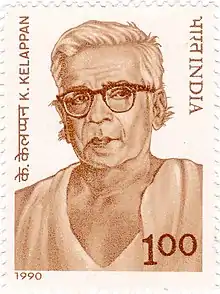K. Kelappan
Koyapalli Kelappan (24 August 1889 – 7 October 1971) was an Indian politician, independence activist, educationist and journalist. During the Indian independence movement, he was the lead figure of Indian National Congress in Kerala and was popularly known as Kerala Gandhi. After Indian independence, he held various seats in Gandhian organisations. He was the co-founder and the first president of the Nair Service Society and was also the founder of Kerala Kshetra Samrakshana Samiti (Temple Protection Movement).[1][2][3]
Kerala Gandhi K Kelappan | |
|---|---|
 | |
| Born | Koyapalli Kelappan Nair 24 August 1889 Muchukunnu, Koyilandy (also known as Quilandy) |
| Died | 7 October 1971 (aged 82) Calicut, Kerala |
| Nationality | Indian |
| Other names | Koyapalli Kelappan Nair, Kerala Gandhi |
| Education | Graduate |
| Alma mater | University of Madras |
| Occupation(s) | Freedom Fighter, Teacher, Editor and Founder President of Nair Service Society |
| Known for | Indian independence movement |
| Title | Kerala Gandhi |
| Political party | Indian National Congress Kisan Mazdoor Praja Party |
| Spouse | T P Ammalu Amma |
| Children | T P K Kidav |
Early life
Kelappan was born in the small village of Muchukunnu at Koyilandy in Calicut, Kerala. His father's name is Kanaran Nair and mother's name is Kunjamma Amma.[4]
He studied in Calicut and Madras and graduated from the University of Madras before starting his career as a teacher at St. Berchmans High School, Changanassery. Kelappan was the founding President of the Nair Service Society and later became the principal of a school run by the society.[5]
As reformer
He fought for social reforms on one hand and the British on the other. He fought relentlessly against untouchability and caste-based discrimination.[6] Along with K. Kumar, he became the earliest in Kerala to remove the suffix to his name that implied caste-status.[7] He was called Kerala Gandhi.[5]
Kelappan laboured incessantly for the equality of all sections of the people. He was a major influence on the Vaikom Satyagraha movement and later led the Guruvayur Satyagraha in 1932. During Gandhi's visit to Travancore to commemorate the Temple Entry Proclamation, he seconded the most critical resolution re-establishing faith in Gandhiji's leadership and the forward steps to be taken in conformity with the Gandhian approach to translate the spirit of the move for social equality. The resolution was presented by K. Kumar of Travancore, a veteran reformer and one of the leaders of the Vaikom Satyagraha who later came to be forgotten by people and historians.[8]
Role post independence
After independence he left the Congress Party and joined the Kisan Mazdoor Praja Party and was elected to Parliament from the Ponnani Lok Sabha seat in 1952. At the end of his term, he left active politics and became a Sarvodaya worker and was actively associated with Bhoodan Movement in Kerala.[9]
Kelappan helped in starting Mathrubhumi and was its editor for a number of years. He worked for unification of Kerala into a new linguistic state. He was also the president of many Gandhian organisations in Kerala including Kerala Sarvodaya Sangh, Kerala Gandhi Smarak Nidhi, Kerala Sarvodaya Mandal and Gandhi Peace Foundation, Calicut.
Some of his political interventions towards the end of his life had been criticised for their communal tinge. These include his opposition to the formation of Muslim-majority Malappuram District in Kerala arguing that it will create a 'mini Pakistan', and his involvement in Tali Temple Movement which aimed at a temple resurrection near a mosque in Angadippuram, in Malapppuram leading to communal tensions.[10] Kelappan was instrumental in the Tali Temple Movement. But before its completion, Kelappan died on October 7, 1971. The temple built with his support stands alongside the mosque, symbolising the present harmony among different communities.[10][2][11]
Awards and recognition
In his honour India Post released a Commemorative stamp in 1990.[12]
References
- "K. Kelappan an unsung hero". The Hindu. 1 November 2012. Retrieved 18 January 2017.
- Kuvalayamala (29 December 2019). "കേളപ്പജി: ആധുനിക കേരളത്തിന്റെ പിതാവ്". Medium. Retrieved 23 April 2021.
- "കേരള ക്ഷേത്ര സംരക്ഷണ സമിതി: Kerala Kshetra Samrakshana Samithi". കേരള ക്ഷേത്ര സംരക്ഷണ സമിതി. Retrieved 23 April 2021.
- "Freeindia > Biographies > Freedom Fighters > K. Kelappan". Freeindia.org. Sh. Kelappan Centenary State Committee Kerala. Archived from the original on 22 April 2003. Retrieved 1 February 2011.
- "Freeindia > Biographies > Freedom Fighters > K. Kelappan". Freeindia.org. Sh. Kelappan Centenary State Committee Kerala. Archived from the original on 22 April 2003. Retrieved 1 February 2011.
- K. P. K. Menon (1972). The History of Freedom Movement in Kerala: (1885-1938) / by P.K.K. Menon. Government Press. p. 116.
- K. Kumarji Smaraka Grantham - 1974 - (K. C Pillai)
- Vaikom Satyagraha Rekhakal - (Prof P C Menon and Adv. P K Harikumar) Pages 353, 299, 160, 217,298 etc
- "SOME PROMINENT LEADERS OF THE FREEDOM STRUGGLE IN KERALA". Retrieved 26 February 2013.
- Ramji (7 December 1968). Samar Sen (ed.). "A Mini-Pakistan?" (PDF). Frontier Weekly. Calcutta. pp. 8–9.
- "തളി ക്ഷേത്ര സമരനായിക യശോദാമാധവൻ അന്തരിച്ചു". Mathrubhumi. Retrieved 23 April 2021.
- K. Kelappan Commemorative Stamp. Indianpost.com. Retrieved on 6 December 2018.